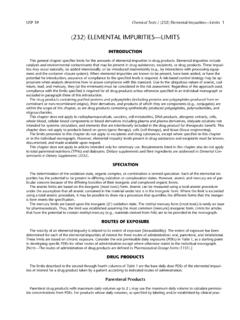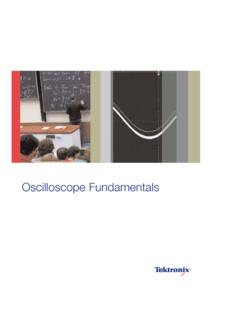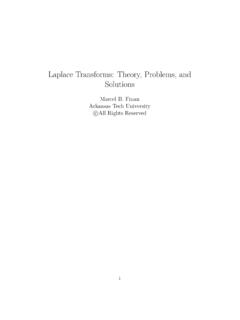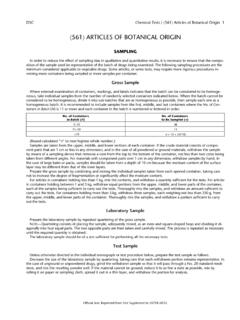Transcription of Principles and Applications of Liquid Scintillation Counting
1 Principles and Applications ofLiquid Scintillation CountingA PRIMER FOR ORIENTATION National Diagnostics Laboratory OF RADIATION AND ISOTOPE OF Liquid Scintillation Scintillation SIGNAL COMPLETE Scintillation AND STATIC DISPOSAL DISCRETE SAMPLE PREPARATION Liquid Scintillation AND RADIATION SAFETYUSA: 1-800-526-3867 EUROPE: 441 482 646022 2004 National DiagnosticsUSA: 1-800-526-3867 EUROPE: 441 482 6460222 LSC Concepts - Fundamentals of Liquid Scintillation CountingLiquid Scintillation Light of the SituationThe chemical properties of an element are determined by its atomic number - the number of protons in thenucleus (and electrons within neutral atoms of that element). Uncharged neutrons, within the nucleus alongwith protons, do not contribute to the atomic number, but will alter the atomic mass.
2 This makes possible theexistence of isotopes, which are atoms of the same element with different atomic weight. Most isotopes are stable,and do not undergo any spontaneous nuclear changes. A subset of isotopes possess too few or too many neutrons tobe stable. These are radioactive. Radioactive atoms spontaneously rearrange their nuclei, emitting energy or par-ticles in the isotopes of common elements are extremely useful in life science disciplines, among others, becauseradioactive atoms can be substituted for their nonradioactive counterparts in chemical formulations. The resultingradioactive compound is easily detectable but still chemically identical to the original material. Two detectionmethods predominate for assaying such incorporated radioactivity. In autoradiography, labeled material is allowedto expose a photographic emulsion.
3 Development of the emulsion reveals the distribution of labeled material. Inthe second detection method, the amount of radioactivity in labeled samples is directly measured, either by a Geigercounter or by a Scintillation counter. In Scintillation Counting , the sample is mixed with a material that will fluoresceupon interaction with a particle emitted by radioactive decay. The Scintillation counter quantifies the resultingflashes of of LiquidScintillation EMISSIONST ypes of Radioactive Emission / Characteristics ofUseful Isotopes / Use of Isotopes in OF RADIATIONAND ISOTOPE QUANTITATIONI onization Detection / Scintillation OF LIQUIDSCINTILLATION COUNTINGThe Role of the Solvent / The Role of Phosphors(Scintillators) Scintillation SIGNALINTERPRETATIONP atterns of Light Emission / Pulse Analysis / Counting Efficiency / COMPLETE ANDSTATIC DISPOSAL ISSUESLSC Concepts - Fundamentals of Liquid Scintillation CountingUSA: 1-800-526-3867 EUROPE.
4 441 482 Radioactive Types of Radioactive EmissionRadioactive decay occurs with the emission of particles or electromag-netic radiation from an atom due to a change within its nucleus. Formsof radioactive emission include alpha particles ( ), beta particles ( ),and gamma rays ( ). particles are the least energetic, most massiveof these decay products. An particle contains two protons and twoneutrons, and thus comprises a stable helium nucleus. particles onlyweakly penetrate whatever matter they encounter. They are unable topenetrate even 10 cm of air. particles are high energy electrons. These are produced during theconversion of a neutron to a proton in the nucleus. particles areemitted in concert with a neutrino (Neutrinos are almost impossibleto detect).
5 The sum of the energies of the neutrino and particle is aconstant for a given isotope, and defines the maximum energy (Emax)which can be observed for any particle emitted from that isotope. Emaxis approached only for particles emitted with a low energy practice a distribution of energies is observed, which is characteris-tic for the emitting isotope. -rays differ from and emissions in that -rays are electromagneticradiation, not particles. -rays are quite penetrating, in many casespassing through up to 5 cm of lead. Additionally, -rays are capableof generating secondary emission from material they pass electron in the material may absorb the energy of the -ray, and bepromoted to an excited state which is no longer bound to its an electron escapes from the atom as a free Characteristics of Useful IsotopesThe list of known radioisotopes is extensive, but the number of iso-topes used in research is fairly small.
6 To be useful as a label in re-search, an isotope must meet a restrictive set of qualifications. First ofall, it must be an element that is already a part of the experimentalsystem. For biological research, for example, isotopes of carbon, hy-drogen, oxygen, and phosphorus are widely used. Alternatively, anelement which can be substituted for another in the system may beused: sulfur isotopes can be used in place of oxygen, for isotopes must also have a reasonable half-life. The half-life ofan isotope is a measure of the rate at which it decays to a nonradioac-tive state. As each nucleus emits its radiation, it eventually reaches astable configuration which will not emit again. Thus a given quantityof isotope will eventually yield a finite total amount of radiation.
7 Eachnucleus decays independently, so the probability of a decay event oc-curring at any time is equal to the probability of any one nucleus de-caying multiplied by the total number of radioactive nuclei number changes as decay progresses, always proportional to thenumber of radioactive nuclei remaining. To express a rate of radioac-tive decay which is independent of the amount of material involved,the time required for the decay of 50% of the starting material, thehalf-life, is a useful quantity. Half-lives may range from millisecondsto thousands of years, a value characteristic of the particular that a 24 hour period is required for an experiment, an iso-tope with a half life (t1/2) of 6 hours would undergo 24 fold reductionin emissions, or a loss of 94%. Most experimentally used isotopes havet 1/2 values of 10 days or determine the number of radioactive at-oms present within a sample at a given time,use the equations above.
8 =decay constantt1/2=half-lifeN=number of radioactive atomsN0=initial numbert=elapsed timeRadioisotopes: Decay Products and EnergiesIsotopeEmissionEnergy(MeV)Tritiu m (3H)Carbon (14C)Sulfur (35S)Phosphorus (32P)Phosphorus (33P)Iodine (125I) Half Life (t1/2) yrs5730 daysTable The Use of Isotopes in ResearchFor many kinds of research, the utility of radioisotopes stems from theirchemical identity with their nonradioactive counterparts. This allowstheir incorporation into tracers , radiolabeled components which canbe followed and detected through a series of reaction steps. Tracers areinvaluable in metabolic studies, where they allow the determination ofthe catabolic and/or anabolic fates of nutrient compounds. Animalsare fed diets containing labeled molecules, such as sugars or amino ac-ids, and the radioactivity is followed through the system until excretionor incorporation.
9 Another use for isotopes has been protein and DNAanalysis studies, where probes which bind to specific macromoleculescan be radiolabeled without interfering with their of radiolabeled biological molecules including tritiated gly-cine and ATP labeled with either 35S or [ -35S]ATP [ -32P] Measurement of Radiation andIsotope QuantitationMost research Applications of radioisotopes, at some stage, requirequantitation of the isotope, which is done by measuring the intensityof radiation emitted. Common nomenclature expresses this intensityas disintegrations per minute (DPM). The SI unit for radiation, theBecquerel (Bq), corresponds to 60 DPM (one disintegration per sec-ond). The curie, an earlier and still prevalent measure, is equal to 1010 Bq. Truly accurate measurement of DPM would require thatevery emission event be detected and counted, which is not possiblein most situations.
10 Additionally, naturally occurring isotopes and cos-mic radiation contribute significant background radiation. Correc-tions for efficiency and background are needed to convert CPM, thecounts per minute measured, into DPM, the number of decay eventswhich actually occurred. Techniques have been developed for apply-ing these corrections, and a great deal of research has been carried outto improve the efficiency of Counting , using various detection [2 - 3H]USA: 1-800-526-3867 EUROPE: 441 482 6460224 LSC Concepts - Fundamentals of Liquid Scintillation CountingLiquid Scintillation (LSC), detailed in the next section, was evolved toprovide a usable method for Counting organic isotopic materials are most often water soluble -emitters. LSC addressesthe need for convenience, reproducibility, and high sensitivity in theseassays.









